Centennial High AVID Students Present iRISE Engineering Projects at Pygmalion Festival
November 7, 2017
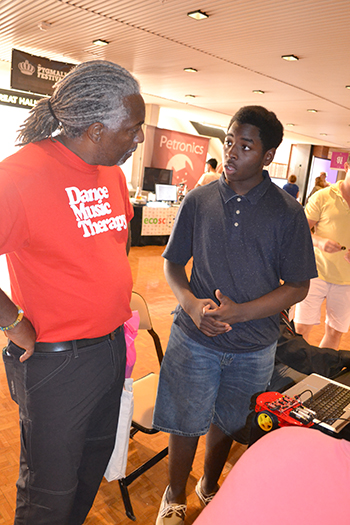
D.J. Jackson (right), Centennial sophomore, interacts with a visitor at the Pygmalion Festival.
What do My Fair Lady, Pretty Woman, Family Guy, and Centennial High AVID students have in common? Pygmalion, a play created by George Bernard Shaw. The first three (or at least an episode or two) were based on the tale of Eliza Doolittle and Professor Henry Higgins, who wants to make Eliza into a proper high-society lady to illustrate the point that no matter the social standing or different way of speaking, all people are the same. Similarly, the Pygmalion Arts Festival, held at the Krannert Center for the Performing Arts from September 20–24, strives to convey a similar message by showcasing all that Champaign-Urbana has to offer, from local bands, to eateries, to innovators and entrepreneurs who work right around the corner. The AVID students who were part of the iRISE-Centennial High partnership fit into this category, and thus were invited to present their projects featuring motor-controlled wheelchairs at the Festival on September 21st.
According to the Festival website, “You can speak directly with innovators and entrepreneurs that build here.” That was the idea behind inviting the students—both the high schoolers and the iRISE graduate students (as well as their teachers and professors) to present their final projects to the public. A part of iRISE’s partnership with AVID program students in Linday Aikman's class at Centennial High School in Champaign, the previous semester, these high schoolers had built working models of motored wheelchairs for use in wheelchair basketball. This had been done under the mentorship of several University of Illinois engineering graduate students, who were introduced to the outreach opportunity by the iRISE program. They had all taken iRISE course (ME598 course rubric), which engages grad students from across campus in conversations around issues of power, privilege, and identity as they pertain to STEM education and outreach, and were then given a chance to change the dialog by mentoring under-served students in Centennial High.
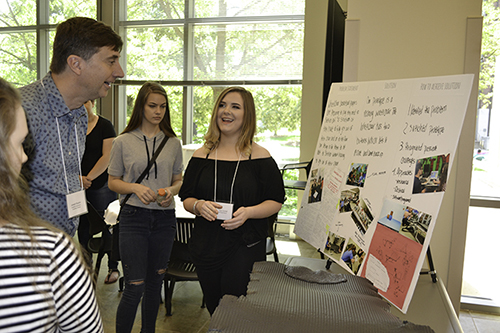
MechSE's Joe Muskin (upper left) looks on as a Centennial student explains about her team's research during the IRISE 2017 Symposium held last spring.
Joe Muskin, the MechSE Educational Outreach Coordinator, who was extremely excited for the general community to see what his students had accomplished, comments on the benefits for both the high schoolers and grad students:
“It's been fantastic. It's always great to get students interested in engineering. These students are feeling empowered. Even if they don't go into engineering, they still gain the ability to do things that aren't too hard for them… I think it's great for the grad students because they can kind of give back and be that mentor that they probably had when they were coming up. Experiencing the mentorship firsthand always gets you going through the hard spots.”
The students also had a more informal poster session at the end of the spring semester the year before. They presented to many other researchers as well as the wheelchair basketball team. The model wheelchairs were a big hit, as was the coding that the students had to work out to make the motors run. Brynne Kenner, a Centennial High School sophomore, explained, “We just coded motors and stuff to make the wheelchair move up and down; a reclining wheel chair. You had to code each motor so it would move a certain way…the most challenging thing was to get it to move up and down because we had two motors, and both motors had to be exactly the same. If something was off, it wouldn't work.”
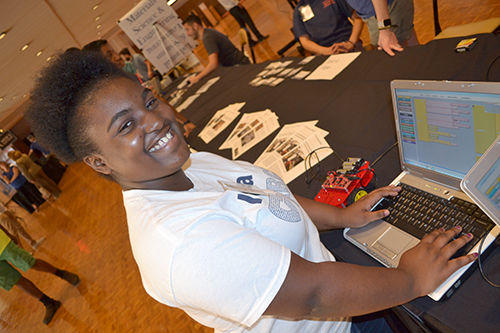
Above: Tiari Hunter, a Centennial High School sophomore, checks over the project's code.
Below: Brynne Kenner, a Centennial High School sophomore, and the completed prototype.
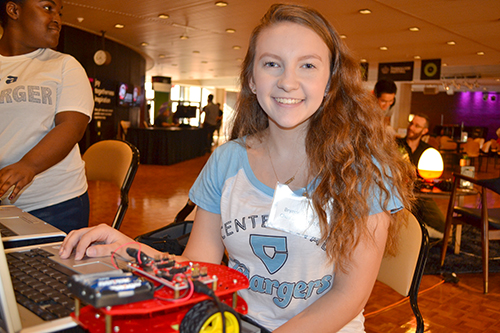
Muskin explained that AVID and iRISE were invited to the event in order to show off how far the students had come in a short semester the year before. He remarked, “They're now bringing it to the community. What's really cool is it went from graduate students to high school students, and now it's going from high school students to the general community. Now the high school students are the teachers…” He felt very confident about the abilities of his students to present what they had learned.
Tiari Hunter, another sophomore at Centennial High School, was certainly not worried about the prospect of presenting her project to the public. She reflected on her experience coding the robot, “I'm not scared, I think it's an amazing opportunity that was given to me. I think I could show other people how cool it is and that they could do it too.” Hunter still was not sure about her career path, but definitely wanted to continue coding as a hobby.
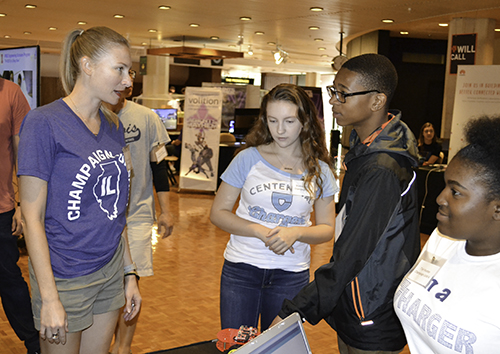
Centennial teacher Lindsay Aikman interacts with her students while setting up for Pygmalion.
The grad students involved with the project through iRISE were an amazing resource for these students. Many of them love working with high schoolers and exposing them to the sciences as a career path, without all the dull homework that school would provide. One grad student, Kazem Alidoost, said, “…I think it's important to support the community and support the kids who are there. They're super brilliant.”
Professor Elif Ertekin, who works closely with the grad students, loved mentoring all the students she had contact with. She exclaimed, “…every time I work with them I find it really inspiring how enthusiastic and dedicated they are to what they're doing, and how they throw themselves into new activities and they're eager to learn… It's inspiring and motivating to be able to watch and see that.”
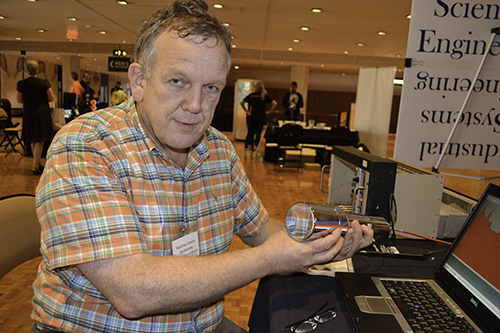
Professor Matthias Grosse Perdekamp (left) at the Pygmalion Festival, sets up his team's booth.
Another professor, Professor Matthias Grosse Perdekamp, had a slightly different motivation to try to get these students involved in science. He said, “On the educational side, I think that my motivation is that wealth that we have in western societies can be used to solve significant problems that we are facing in the future. [Our ability to] largely stems from our knowledge of science and technology.” He continued on to say, “There is what I would call a strong disinterest in science and technology in young Americans. The most important part of these camps is to get young students in contact with science."
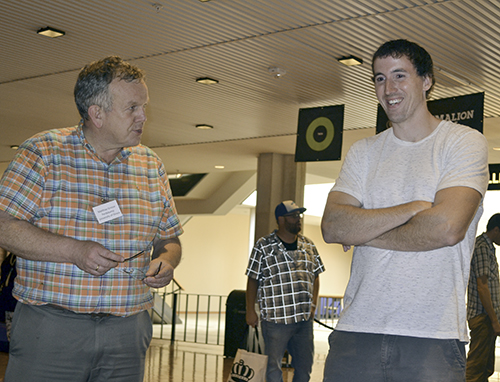
Matthias Perdekamp and Chad Lantz set up for Pygmalion Festival.
Professor Grosse Perdekamp loved teaching and getting to know all the students in his group. He complimented, “We have very smart kids. I think all it takes is to somehow get them interested. I think they do well once their interest is sparked. They are certainly capable of doing it and doing it well." He worked specifically with a student named Zip, who joined his physics research group studying particle and nuclear physics through the Physics Young Scholars program, which is under the umbrella of iRISE. Professor Grosse Perdekamp helped Zip present his findings at the festival, while also relating how the results helped the graduate students’ research as well.
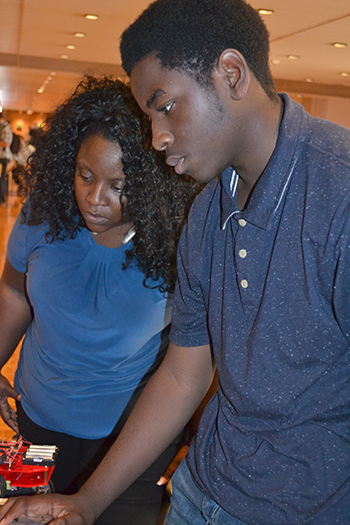
D.J. Jackson (right), Centennial sophomore, walks his mom, Antonia Jackson, through the project's code.
Antonia Jackson, parent of DJ Jackson, a sophomore at Centennial High School, had nothing but praise for the program. She was extremely excited when DJ came home and told her that he would be programming robots for a project for iRISE. DJ had always been involved with robotics and coding and was excited to put his previous experiences to work in building the wheelchair. When asked to comment on how the iRISE program had helped her son, Jackson replied, “I’m just really excited about iRISE and the way that it puts the kids in the path of a lot of great people. It allows them to run into people that they may not have run into before and really see what life after high school looks like.”
The iRISE presentations at the Pygmalion Arts Festival were a resounding success. They allowed high school students who had become experts on the programming and testing of small motors to then present their findings and interest to the public. In an age where the advance of technology is so fast-paced, it is encouraging to see that teachers and older students can help younger students become true experts in the emerging technologies. Not all of these students will now necessarily go into the sciences or engineering. However, as Professor Grosse Perdekamp remarked, “…I should say that it's not science or engineering only, it's the humanities and many other disciplines are important. So I think it's successful if a good fraction of our students end up being interested in science. That's what we really aim for.” It is up to the student to decide where their interests lie and what they want to make a career. IRISE’s intention is simply to get students in contact with these sciences in order to better inform their choice.
Story by: Nick O'Connell, I-STEM Undergraduate Student Worker and a sophomore in Mechanical Science and Engineering
Photographs by: Elizabeth Innes, Communications Specialist, I-STEM Education Initiative.
For more I-STEM stories about IRISE, see:
- Engineering Grad Students Introduce High Schoolers to Engineering Via IRISE
- iRISE Course Prepares Engineers for Community Outreach
- iRISE and Denos Work to Get Students Hooked on Science in Middle School
- Physics Center Rises to the Challenge: iRISE Makes Learning Science Fun
More: 8-12 Outreach, Centennial, iRISE, MechSE, Underserved Minorities, 2017
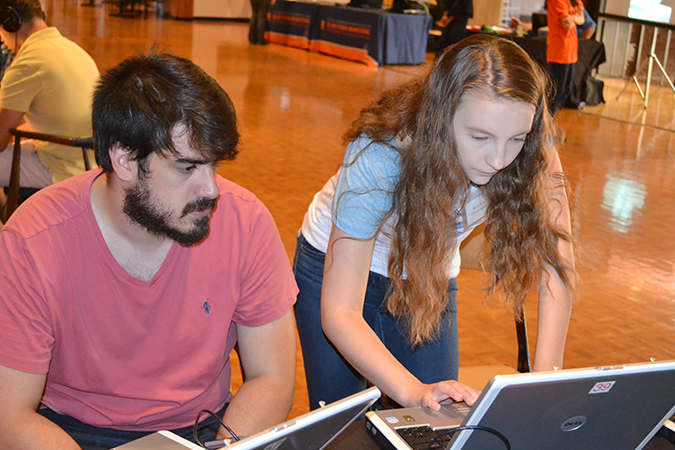
Left to right: Kazem Alidoost, MechSE PhD student, and Brynne Kenner, Centennial sophomore.













.jpg)
















